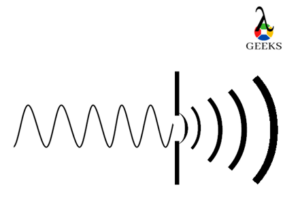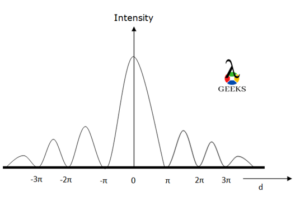In this article, we are going to discuss different wave properties of diffraction with detailed facts and examples.
The following is the list of wave properties of diffraction that we are going to see in the topic:-
1. The amount of diffraction depends upon the amplitude of the wave
If the amplitude of the wave is larger than the size of the opening, then the wave will bend more to pass through the opening, and hence the wave will diffract more.
The length of the slit is greater than the amplitude of the wave focused through the slit then the wave will easily penetrate through without diffracting.
2. The smaller the size of the opening, the more will be the diffraction seen
If the size of the opening is bigger, then it will be easy for light to penetrate through, and hence, no diffraction of light will be seen.
If a beam of wavelength λ is pass through a slit of length ‘2d’, where the amplitude of the wave passing through a slit is almost equal to the length of the slit, then the wave will bend less to penetrate through the slit as shown in the below figure.

If the reduce the length of the opening of a slit to half, that is ‘d’, then now the light wave will bend more to pass through the slit.

Due to this, the diffraction of the light wave seen will be more. As we keep on reducing the size of the slit, more and more light wave bending will be observed and hence more diffraction will be seen.
Read more on Reflection vs Diffraction: Comparative Analysis.
3. The light waves diffracting from the openings forms the interference patterns
In case, there is more than one opening through which light waves can travel, the fringes of the waves will interfere with each other forming different patterns like the one shown below.

Image Credit: Pixabay
The waves interfering with each other form various patterns depending upon the size of the slit, the number of slits through which waves can travel, diffraction of light, and wavelength of the beam.
4. The wave bends around the edge of the obstacles on diffraction
When the wavelength is comparably equal to the dimension of the barrier on which it strikes, the wave bends towards all the edges of the barrier and we can see the diffraction of the light.
If the wavelength is less compared to the dimensions of the obstacles, then the light wave will not bend towards the edges and no diffraction will be observed.
If you have noticed, even if there is only one loudspeaker in a hall at one corner, the entire audience is able to hear the sound amplified from the loudspeaker. This is due to the diffraction of the sound wave. The sound waves bend when encounters every small object in the hall and when strikes the walls of the hall, and even spreads outside the hall by bending from the opening of the hall like doors and windows.
Since light bends towards the edges of the objects we can see the bright edges of the translucent or opaque objects.
Read more on 9+ Diffraction Of Light Examples: Detailed Insight And Facts.
5. The greater is the diffraction angle if the wavelength is shorter
The diffraction of the wave is governed by the equation,
Sinθ =nλ/d
Where θ is a diffraction angle
λ is a wavelength
D is the width of the aperture
Hence, diffraction angle θ is equal to,
θ =Sin-1nλ/d
From the above equation, we can say that, as the wavelength of the beam increases, the angle of diffraction will decrease accordingly.
Read more on Does Wavelength Affect Diffraction: How, why, When, Detailed Facts.
6. The minima of the wave are not perfectly dark on diffraction
The minima of the wave is a dark fringe formed on the screen. The intensity of the light wave at minima is very low compared to the maxima of the diffraction pattern.
The minima are not perfectly dark as compared to that formed by the minima formed by the interference pattern which is completely dark.
7. All maxima are not of the same intensities
The intensity of the maxima at the center of the pattern formed on the screen due to diffraction is the maximum and diminishes as we go towards left and right from the center.

This is due to the fact that the intensity of the light decreases as the distance from the source increases. The distance between the source and the center of the screen where we get the bright fringe is the shortest distance that we can have between the source and the screen and increases equally as the separation from the center increases.
Read more on Diffraction vs Dispersion:Comparative Analysis.
8. The diffraction fringes are not equally spaced
The distance between the fringes is wider at the center of the diffraction pattern formed on the screen and goes on reducing as we go away from the center.
The intensity of the light is highest at the center and the width of the fringe is bigger compared to subsequent fringes. The width of the fringes diminishes at successive fringes and therefore the spacing of the fringes decreases consecutively.
Read more on Does Frequency Affect Diffraction:How And Detailed Facts.
Frequently Asked Questions
What is diffraction?
The angle at which the beam of light diffracts depends upon the wavelength of light.
If the wave propagating in a medium encounters an obstacle or an opening, then a wave will bend, and travels through or change the direction of propagation, this phenomenon is called diffraction.
What are some examples of diffraction of waves?
There are various examples of diffraction that we come across in nature.
The waves spreading across the ocean, scattering of light from the small slits, sound traveling all across the corners of the room and even outside, etc are some examples.
How interference is different from diffraction?
Diffraction can occur by only one wave whereas at least two waves are required to interfere to produce an interference pattern.
The minima formed due to interference is perfectly dark, the fringes are of equal intensities and are equally spaced; so is not in the case of the diffraction pattern.
What is the central maximum in case of diffraction?
The central maximum lies at the center of the diffraction pattern.
The intensity of the light is maximum at the center as the distance between the source and the screen is minimum hence it is called the central maximum.
Where is the fringe width maximum in the diffraction pattern?
It is a gap between the dark and bright fringes of the diffraction pattern formed on the screen.
The fringe width is maximum at the center of the diffraction pattern and decreases along with the intensity of the light towards both sides horizontally.
Also Read:
- Can sound waves be reflected
- Transverse wave vs longitudinal wave
- How to find energy of a photon from wavelength
- Examples of electromagnetic waves
- Why does light exhibit both wave and particle characteristics
- How to find energy with given wavelength
- How to calculate photon energy from its wavelength
- Electromagnetic waves types
- How to find the amplitude of a wave
- How to find the frequency of a wave
Hi, I’m Akshita Mapari. I have done M.Sc. in Physics. I have worked on projects like Numerical modeling of winds and waves during cyclone, Physics of toys and mechanized thrill machines in amusement park based on Classical Mechanics. I have pursued a course on Arduino and have accomplished some mini projects on Arduino UNO. I always like to explore new zones in the field of science. I personally believe that learning is more enthusiastic when learnt with creativity. Apart from this, I like to read, travel, strumming on guitar, identifying rocks and strata, photography and playing chess.